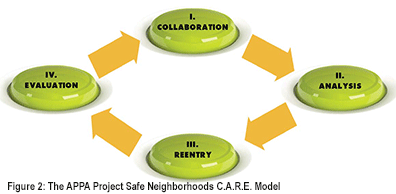C.A.R.E. Framework
Recognizing the continued prevalence of crime in local communities, the U.S. Department of Justice implemented the Project Safe Neighborhoods Initiative (PSN). Research had found that as much as 50 percent of homicides in Boston, Chicago, and Los Angeles were gang related (Blumstein, 1995; Braga, Pierce, McDevitt, Bond, & Cronin, 2008; Pritchard & Evans, 2001), with over 90 percent of these homicides involving a firearm (NGIC, 2009). Interestingly, up to 80 percent of homicide offenders and 56 percent of victims were shown to be probationers and parolees (Bowman, 2005). To assist community corrections agencies involvement with PSN, the APPA created the PSN-inspired C.A.R.E. (collaboration, analysis, reentry, evaluation) framework (DeMichele & Matz, 2010; Matz, Lowe, & DeMichele, 2011).

Below is a brief overview of each component.
Collaboration »
It is up to each probation and parole department to declare their role when working with law enforcement, prosecutors, universities, community-based organizations, and others. Each partner brings several advantages to any collaborative effort. Law enforcement provides enhanced supervision opportunities for offenders in the community. Prosecutors and the courts provide sanctions for noncompliance (Buntin, 2010). Research organizations conduct program evaluations, the results of which can be a springboard and justification for additional funding. Community organizations provide social service options for offenders. However, collaborating with outside agencies is no walk in the park—it takes work. Collaborations can vary in size, composition, and structure (Carter et al., 2005) and may face many obstacles. Successful collaborations will involve extensive networks, a clear unified goal, support from respective home agencies, clear leadership and vision, clear management structure, a shared identity, free-flow of communication, trust, and accountability (BJA, 1997b; Bradford, Duncan, & Tarcy, 2000; Carter et al., 2005; Giacomazzi & Smithey, 2001; Hardy, Lawrence, & Grant, 2005; Katz & Bonham, 2009; Murphy & Lutze, 2009; Phillips, Lawrence, & Hardy, 2000; Stojkovic, Kalinich, & Klofas, 2008).
Analysis »
A commonly understated phase of many projects, community analysis (a.k.a., problem analysis) serves as a precursor to program development (Braga, McDevitt, & Pierce, 2006). Agencies should rely on both official data and officer perceptions when examining local crime problems. A well-qualified research partner can assist and many collaborative partnerships will find the use of a community analysis subcommittee (a.k.a., steering committee) beneficial. There are several strategies for researching crime patterns (e.g., gang membership, gang behavior), including crime mapping, examination of national Uniform Crime Report (UCR) data, and surveying of government agents and the public. Methods will vary based on jurisdictional need. The results of the analysis provide information needed to develop a comprehensive criminal justice response.
Reentry »
Developing a response strategy will differ depending on the criminal context and goals to be achieved. Various programs addressing the prevention, suppression, intervention, and the reentry of gang violence exist. While community corrections concerns the back-end of the justice system, probation and parole officer experiences can be useful for prevention programs such as the Gang Resistance Education And Training (G.R.E.A.T.) which educates youth about the dangers of gang membership (Esbensen & Osgood, 1999). Many community corrections agencies assist in the suppression of gangs through information-sharing in police-probation partnerships. This sharing also helps probation and parole officers prosecute technical violations as they occur in the community (Anonymous, 1999). However, probation and parole’s primary concern is reentry and offender desistance through behavior change. Offender reentry is best addressed through the careful assessment of the likelihood (i.e., risk) of recidivism and treatment of offender criminogenic needs (Taxman & Thanner, 2006). Offenders are more successful when their reentry has been planned prior to their release from a correctional facility. Services addressing the offender’s individual needs (e.g., mental health, substance abuse, housing, employment) must start while the offender is incarcerated and continue through their release to the community (Parent & Barnett, 2004). Several responses to crime, involving a multi-agency effort, integrate prevention, suppression, and reentry into one cohesive program. Such programs include Boston’s Project Ceasefire, the Boston Reentry Initiative, and Project Exile (Braga, Kennedy, Waring, & Piehl, 2001; Braga, Piehl, & Hureau, 2009; Rosenfeld, Fornango, & Baumer, 2005).
Evaluation »
Program evaluation is an integral part of any program’s success. Evaluation exposes the strengths and weaknesses of a program or service (Maxfield & Babbie, 1998). The APPA C.A.R.E. model demonstrates that the process of collaborating, analyzing the problem, shaping reentry, and evaluating the program are cyclical in nature. Using a wide array of sources and analytical methods, researchers will help community corrections agencies determine what components of their program are successful and which need to be revised. The program evaluation will help strengthen collaborations, further narrow the community analysis, and improve program practices.
Brief of APPA C.A.R.E Report »


